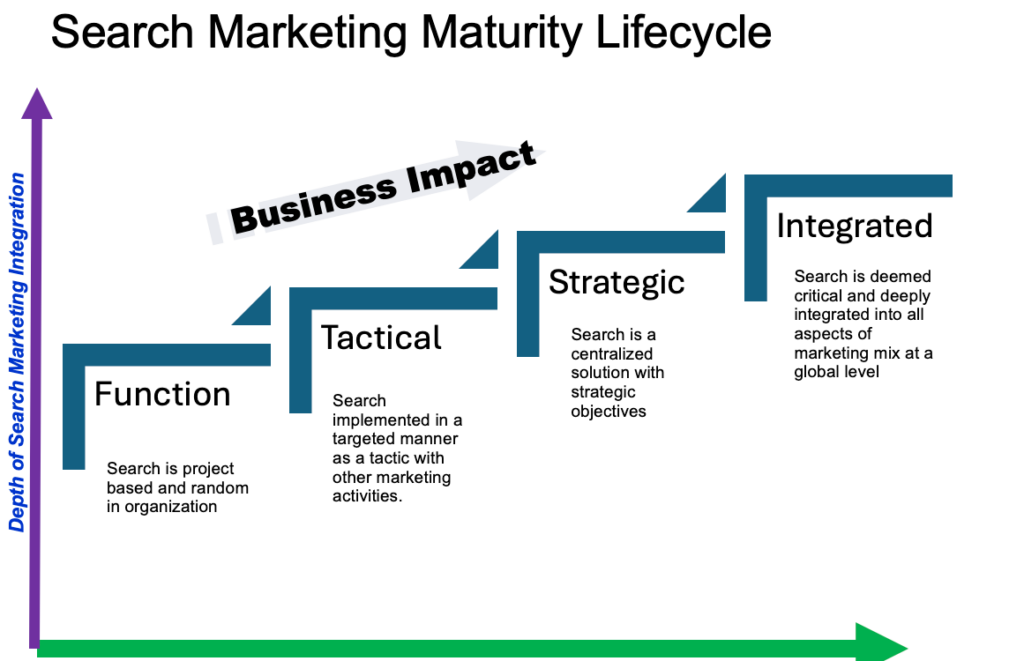Sometimes, a framework emerges that becomes a north star—not just for client transformation but also for agency growth. For me, that was the Search Maturity Lifecycle. Conceived initially brainstorming with Marshall Simmonds during our time at Outrider, it gained broader traction after a panel discussion in New York and a pivotal presentation at a conference in Xiamen, China, in 2007, where a couple of multinationals engaged us to help them make the transformation.
This epiphany wasn’t just about helping clients—it was about reshaping how we grew our agency by deepening our role from tactical project support to trusted strategic advisor.

Transforming From One-Off Projects to Mission-Critical Integration
“The deeper and more integral search is to the organization, the greater the business impact.”
We started with the simple idea that the more integrated search efforts were in the organization, the greater the business impact. Most SEO activities are reactionary—a whack-a-mole of isolated projects. They’re chaotic and disconnected. Different business units run their own programs, and results are inconsistent.
However, as organizations mature their use of Search, it becomes more embedded—first tactically (coordinated with social, PR, or media planning), and then strategically. Eventually, it becomes a mission-critical function, wired into global operations and content workflows.
Not many companies have reached this pinnacle of Search being mission critical, butt those who do see transformative results.
Actionable Takeaway:
- Map your organization’s current search maturity level.
- Identify the next logical step—whether that’s unifying reporting, aligning with content strategy, or creating a shared roadmap.
- Identify ways to highlight the importance of search and collaborate with teams to integrate better.
The Strategic Payoff: From $10K Projects to CMO-Level Advisory
“A project might be $10,000, but building centers of excellence? That’s strategy—and strategy has real value.”
One of our early ambitions was to shift client relationships from transactional to transformational. When search became strategic, we weren’t just solving SEO problems—we were helping organizations operationalize search.
This elevation meant building frameworks: scalable audits, Centers of Excellence, and knowledge bases. It also meant being embedded in marketing calendars, content workflows, and global go-to-market plans.
That’s how we reached the point where P&G’s CMO called us the “McKinsey of Search.”
Actionable Takeaway:
- Audit your current engagements: Are they mostly task-based? Explore how to scale your impact by offering process optimization, governance models, or capability building.
From Tactical to Transformational
“The more mature the search program, the fewer moving parts. Search becomes second nature, not second thought.”
This epiphany changed the trajectory of our business. We weren’t just doing SEO anymore—we were enabling enterprise change. With fewer fire drills, clients saw consistent gains. And we, as partners, became more focused, more embedded, and more trusted.
Final Action Plan:
- Move clients up the Search Maturity Lifecycle.
- Focus on system-level change, not just SEO fixes.
- Elevate your role from project executor to strategic enabler.
- Deliver business results, not keyword rankings.
Creating a Culture of Search
“When they ask you to write the process docs, you’re no longer a vendor. You’re part of the DNA.”
We used to celebrate when a client asked us to help update their web standards or documentation. It meant we were wired into the organization.
We built a knowledge base that housed best practices, modular training, and even methods to harness nternal search behavior data. When clients searched this knowledge base, we’d monitor trends—and create new training each month based on demand for specific topics.
Actionable Takeaway:
- Build (or co-own) your client’s internal knowledge ecosystem and integrate into the process where you can get the buy-in and enforcement of the integration.
- Track usage data to identify skill gaps or process bottlenecks.
Data-Driven Enlightenment: Show the Cost of Friction
“If 95% of your search visitors leave without converting, you are the problem. And no amount of traffic will save you.”
In one pitch, I told a VP that we could add $12M in revenue per month with improvements. His response? “I don’t get out of bed for $12 million.”
So I flipped the script: “You’re the reason I can’t deliver more.” The workflow and rules created backlogs for content creation and website adjustments. Most of the team believed direct sales were the only true sales opportunity so a limited budget was allocated to web initiatives.
That wake-up call changed everything. He leaned in. We reframed the conversation from keywords to business impact—and he became our biggest advocate for integration and a Search Center of Excellence.
Actionable Takeaway:
- Don’t just present traffic forecasts. Show missed opportunity—the delta between potential and actual performance.
- Map friction points in the conversion path. Quantify the cost of bureaucracy, poor UX, or technical bottlenecks.
SML Growth Strategy
•By growing existing clients along the SML we gain additional revenue and margin without needing more clients.
As we refined the Search Marketing Lifecycle framework and worked with clients, this approach reshaped our agency in several ways.
- Focused our sales and marketing efforts – By identifying Global 200 clients with active Search Marketing activities we could focus on a maturity framework rather than why they should engage in Search Marketing.
- Phase-based solutions alignment – Created a set of services, tools, performance metrics, and client management methods that help move the client up the maturity lifecycle.
- Offset Low Margin Efforts with Tools and Process – Looked for ways to leverage tools, processes, and labor more efficiently to reduce the costs of unbillable, non-strategic, or goal-driving efforts.
- Strict Focus on Performance Metrics – Focused on performance, precisely revenue, cost savings, and integration benefits, which are the key drivers of maturity uplift.
Final Thoughts
“Strategic partners are more valuable than project implementers. Become indispensable.”
The Search Maturity Lifecycle wasn’t just a framework—it was a philosophy. It taught us to look beyond the task at hand and focus on long-term transformation. And it became a blueprint—not only for client success but for the kind of agency we wanted to build.